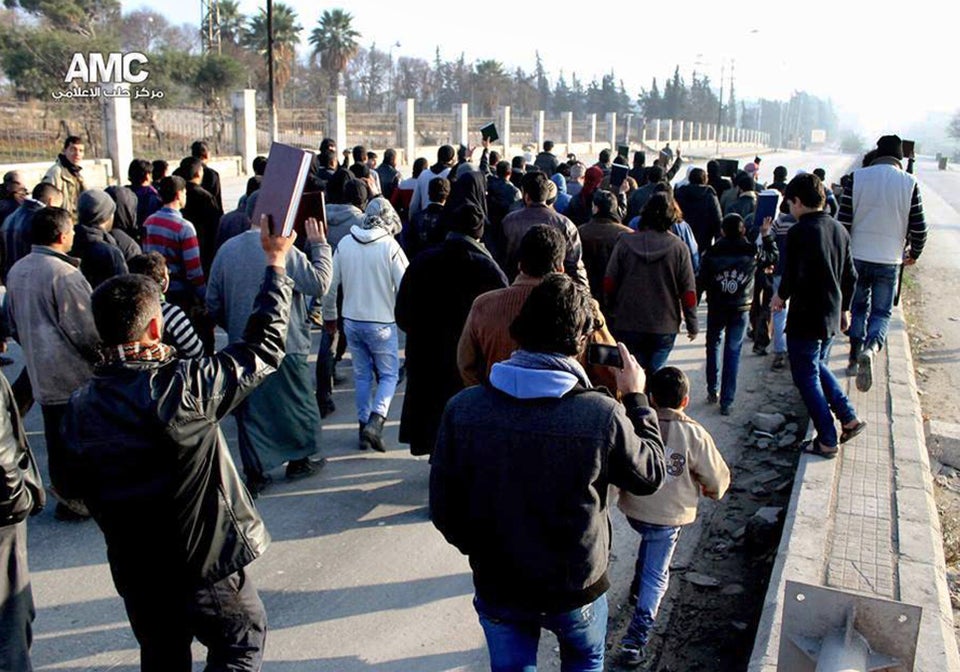The first images that came out of the Syrian city of Homs right after the start of the protests in the spring of 2011 were pictures and movies of chanting men, of citizens dancing in the city’s squares while calling for freedom and democracy. “Homs the audacious,” they sang, lauding their hometown.
Then came the footage of shells and the photos of civilians in body bags, of tanks and soldiers and barely armed opposition fighters, of a besieged, restive city that more closely resembled a moon crater than the bustling center it once was. The flow of images eventually slowed down as the conflict persisted and the city and its inhabitants became largely cut off from the world.
After so many months with barely any news emerging from the town, a new, harrowing documentary by Syrian filmmaker Talal Derki once again gives the world a gut-wrenching glimpse into life in the isolated city.
With footage shot by Derki and Syrian media activists, "Return to Homs" follows a group of young friends from August 2011 to August 2013 as they fight to stay alive amid the brutal crackdown by the army of Syrian President Bashar Assad. The film, which won the World Cinema Grand Jury Prize at the Sundance Film Festival, documents how each of them is increasingly drawn into the conflict, while the city around them slowly turns into a wasteland.
Before the start of the protests, protagonist Abdul Basset Saroot was a revered goalkeeper on the Syrian national soccer team. Once the demonstrations took off, he quickly became a “chanter,” leading the crowds in peaceful protests by appealing to Homs' audacious past. His friend Ossama, a bright and cheerful media activist, spread Basset’s words around the Internet.
Yet as the war progressed and his city became one of the main targets of the Assad regime, Basset gave up his hopes for peaceful resistance and became the leader of a group of frontline fighters. While following the young man around throughout the front lines, the cameras capture the sheer destruction that has grasped Homs -- rows and rows of desolate streets filled with debris, collapsed houses, hastily abandoned living rooms and rotting bodies. “We’d never win if we stay peaceful,” Basset tells the camera.
“Basset was an icon of pacifism,” explained "Return to Homs" producer and cinematographer Orwa Nyrabia at a recent screening organized by the Open Society Foundations in New York, highlighting the young man's change in perspective.
The New York screening of "Return to Homs" took place as representatives of Syria’s regime and opposition were gathered in Geneva to discuss a peace deal, including aid access to Homs. Several of the city’s neighborhoods had been cordoned off for weeks, with activists warning that people inside the siege were dying of starvation.
While negotiators in Switzerland eventually reached an initial compromise for women and children to be evacuated from the city before an aid convoy went in, regime forces held up the trucks on the outskirts of the town. The negotiations ultimately failed to bring a ceasefire or aid relief to Homs' residents, who are still waiting. According to Nyrabia, the producer, some 4,000 civilians and between 800 and 1,500 fighters are holed up in the city.
An activist told the Los Angeles Times last week that only “ the lucky ones still have bulgur wheat.” The majority of Homs' residents are said to live off non-poisonous plants.
Nyrabia criticized the international community for remaining on the sidelines in the face of such atrocities, for failing to put enough pressure on the Assad government and for presenting international options as narrowly as either military intervention or staying out. "Between those two there are a million options,” he said.
For the sake of the people trapped in Homs, it may be time for the world to take a look at Derki’s film.

